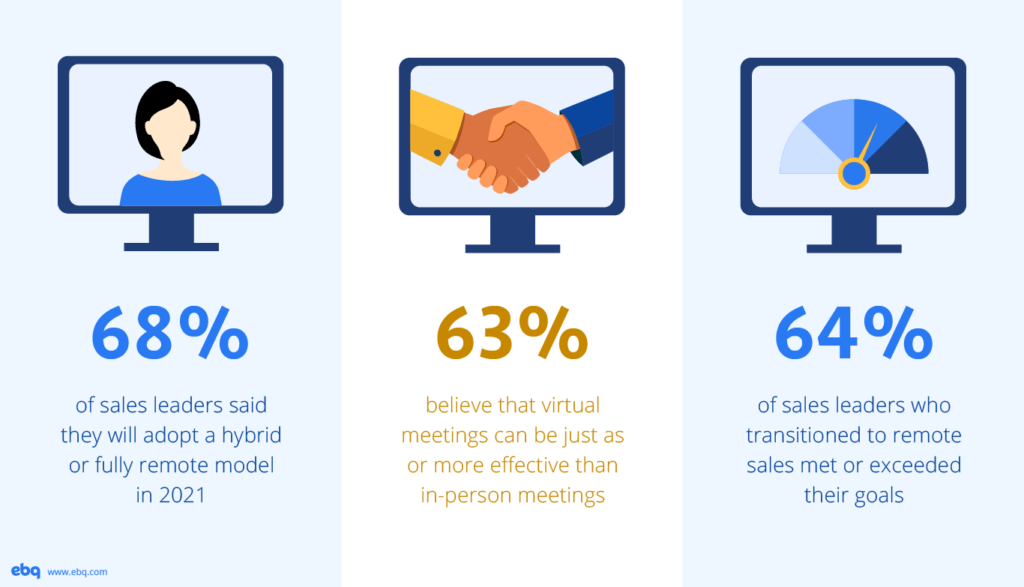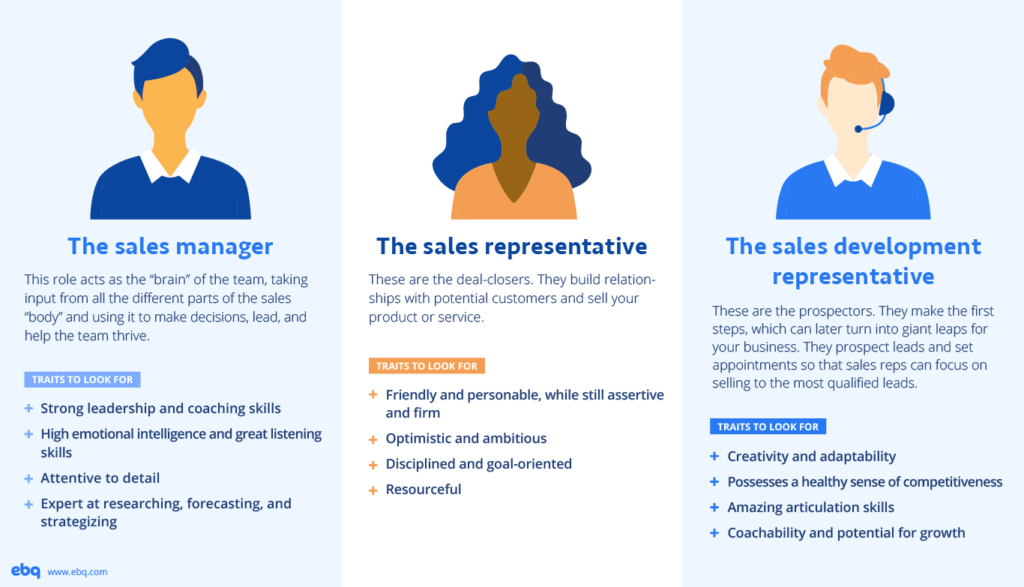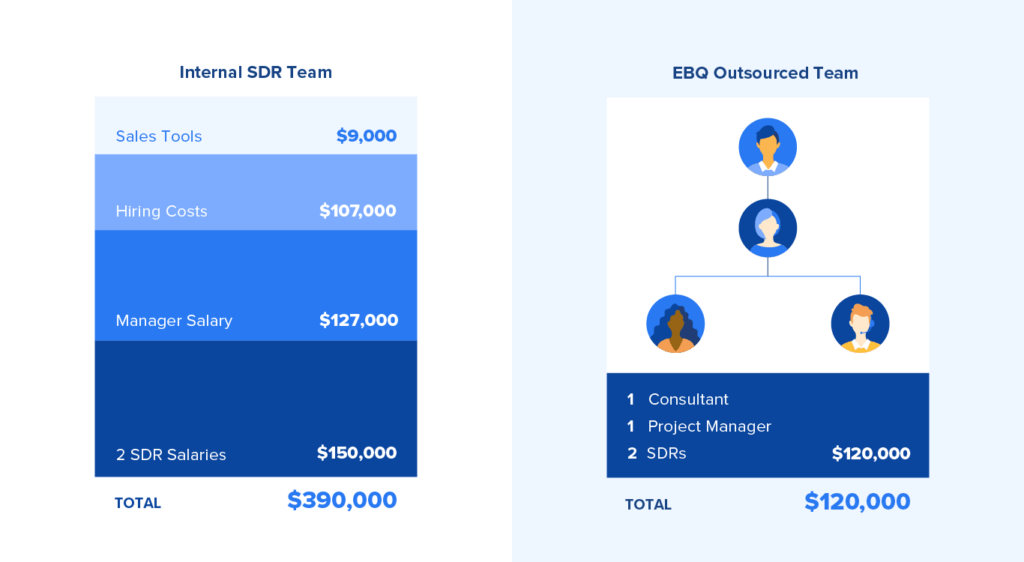Connect with a Consultant
Fill out your information with the form provided and one of our team members will reach out to you shortly.

This post was originally published in February 2020 and has been updated for accuracy and comprehensiveness.
Building a successful inside sales team is all about putting the right people in the right positions at the right time. Companies must consider numerous factors, including structure, hiring practices, training, and tools to enjoy sales efficiency and increased revenue. In this blog, we will discuss the difference between inside and outside sales, how to plan your inside sales team, best practices for hiring, and tools to set your team up for consistent success.
Setting up your inside sales team starts with understanding the difference between inside and outside sales. Inside sales representatives make sales remotely over the phone, while outside sales representatives meet with clients in person to close deals.
Traditionally, outside sales have accounted for a majority of sales. However, improvements in technology and sales processes have led to an increase in inside sales. Today, inside sales representatives account for nearly half of all sales representatives (47.2%).
As the business landscape shifts towards remote operations, more companies are utilizing an inside sales strategy. In 2017, Xant.ai ran a study and found that large organizations were dominated by outside sales representatives. On the other hand, smaller organizations utilized a greater percentage of inside sales representatives. However, a 2021 Hubspot sales survey uncovered a major shift:

Additional research from PointClear indicates that inside sales are better for your business’ bottom line: while an outside sales call costs a business $308 on average, an inside sales call only costs $50. It’s no wonder that 37% of high-growth businesses use inside sales as their primary sales strategy, compared to 27% for outside sales.
Before you start hiring, it is vital to develop a comprehensive inside sales team structure. Aside from strong leadership, many different roles will turn your sales team into a well-oiled machine.
With the rise in sales technology, some companies have chosen to utilize sales automation. While this can be an effective strategy in certain situations, automated tools cannot replace real sales team members. Remember, building a successful inside sales team is all about working together to achieve your goals.
Many successful inside sales teams are built using the Triple S System:
By having a clearly defined role, each member of your sales team can work both independently and collectively to move your business forward. This chart below illustrates each role and their importance:

The hiring process looks different for every inside sales team: filling each role will depend on your company size, the product you sell, and, of course, your budget.
Making the most effective use of your hiring budget allows for greater company growth. This is especially top-of-mind when hiring SDRs, an in-demand role that can be difficult to retain. You may want to consider hiring an outsourced team of SDRs rather than hiring and managing an internal inside sales team.
On cost comparison alone, let’s look at the differences between an outsourced SDR team versus an internally built one:

Outsourcing your SDRs not only gives you a predictable recurring cost, it helps you avoid the pitfalls of sales automation by incorporating an expert human touch. Your team of qualified reps will effectively handle the sales development process, allowing your managers and sales representatives to focus on closing deals.
At its core, sales is a deeply interpersonal skill. A good sales representative or SDR must be warm, personable, and trustworthy in order to win a client’s business. Thus, it’s always important to remember the adage from Harvard Business Review: “In sales, hire for personality, then train for skills.”
Of course, experience and accomplishments are important to consider during the hiring process. However, they are not everything. Candidates with good personalities are often more receptive to learning new skills, which will help you win even more business. Plus, you’ll increase synergy and morale across your team.
To ensure you’re hiring the right blend of personality and skillset, define and build profiles for each role. Consider both desirable traits for candidates and the traits of your business, such as size and company culture. Then, write job descriptions based on those profiles.
Developing a successful inside sales team requires clear and defined processes, but in an ever-changing business landscape, adaptability is just as important.
Look for guidance from within your team: current sales reps, other managers, and even company executives can be beneficial in determining a candidate’s best fit, as well as improving the hiring process overall as your company grows.
Additionally, you should always be recruiting. Never close yourself off to a candidate who may be perfect for your team, even when the timing isn’t perfect. You never know when you may need to hire again.
Continuous recruitment is vital for hiring and maintaining a superstar team of SDRs, which is another reason why outsourcing is an excellent option. Rather than focusing on hiring, training, and replacing your SDRs, you can focus on closing deals and managing your department as a whole.
You never get a second chance to make a first impression, so your onboarding process will set the tone for your new hires’ tenure at your company. Therefore, providing a welcoming and comprehensive environment in your new hire onboarding is vital.
Think of it as an investment: it can take up to three months for a new hire to ramp up to full productivity; in that time you can build a foundation that will lead to long-term success. It all starts with a solid onboarding plan that balances studying training materials and learning through experience.
Of course, time is of the essence, and fast-growing companies may need a new hire to contribute right away. This is another excellent reason to consider outsourcing your SDR team, as these teams are already trained and ready to jump straight into the role.
Inside sales success starts with open communication and understanding. By determining goals and sharing them with your sales team, you can all work together to grow your business.
In 1981, George T. Doran shared his technique for setting goals using the acronym S.M.A.R.T. Still used today, it stands for:
In sales, setting SMART goals is easy thanks to the use of Key Performance Indicators, or KPIs. They can include:
Our team has published a list of SDR Metrics That Will Make Your Team Successful, breaking down the most important KPIs and sharing ways to integrate them into your business.
Keep your eye on these metrics at all times. This not only promotes accountability and performance but can help with setting SMART goals. If employees are consistently missing goals set by management, it can help you assess their performance or rethink your goals.
If you want your team to Always Be Closing, you have to Always Be Training.
Training isn’t just for new employees: even your top-performing team members can benefit from learning new skills. On a championship-winning sports team, all members train together, from star players to backups to rookies. The same can be said about sales teams: when everyone on the team buys into training, your business can see tremendous success.
The Society for Human Resource Management describes coaching this way:
"Coaching is frequently used to assist individuals as they prepare for or move into new assignments, improve work habits, adapt to a changing environment or overcome specific obstacles.”
Your business and your team will always be changing and growing, so a solid training structure can keep everyone moving towards the same goal. As with hiring processes, always look for ways to improve your training and listen to feedback from both new and existing employees.
New sales technology isn’t just about sales automation: there are a number of useful tools that can help take your inside sales team to the next level. Integrating different sales tools into your team’s day-to-day can help them be more productive, keep track of work, and even help find leads.
Customer Relationship Management (CRM) systems like Salesforce can help you keep track of leads and organize data for easy management. With marketing automation tools like website forms, you can collect leads with ease and nurture them throughout the sales pipeline.
Sales prospecting tools are another great way to leverage technology to reach your goals. From household names like LinkedIn to good old-fashioned word of mouth, there are plenty of ways to cultivate leads in the modern world. Check out our handy guide to the Top 8 Sales Prospecting Tools to learn more.
The modern age has also brought about the rise of webinars, or online seminars. Without leaving your computer, you can use tools like GoToWebinar and WebEx to develop new processes and techniques to find, nurture, and close each and every lead.
The world is moving towards inside sales, and you won’t want to be left behind. Building a strong inside sales team means developing a strong structure, hiring the right people within your budget, and continually identifying opportunities to improve your business practices, KPIs, and employee training.
Outsourcing your inside sales team can open the door to business growth, and EBQ is here to help! From SDRs to Sales Representatives to Customer Experience, our highly-trained sales specialists are ready to take your business to the next level. Contact us to get started today.
Fill out your information with the form provided and one of our team members will reach out to you shortly.
6800 Burleson Road
Building 310, Suite 265
Austin, TX 78744
©EBQ 2023 All rights reserved.
Tell us about yourself and we’ll get in touch shortly.
